Lomas
A British Family
Coventry
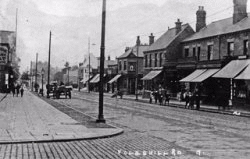
Old Foleshill in Coventry, c. 1900
-courtesy of coventry.gov.uk
Ancestry.ca- Begin a membership with Ancestry.ca to research the Lomas Family from Coventry as well as other Lomas Family Trees registered as "Public" on their site.
Wikipedia Entry- History of Coventry
CWN- Coventry & Warwickshire Network website
BBC NEWS- Coventry & Warwickshire website
Coventry City Council website
Coventry Telegraph website
Older People's Information Network website
House of Images website
HPAC - Historic Photographic Archives website
Throughout the millennium, British industry has been influenced by the productive, high-calibre labour of the Foleshill people. Over centuries, hard work and resiliency have been deeply embedded into their character and moral fibre. Significant changes over a short period of time can only occur through the applications of new technology and hard work. Overall, the contributions of the original Foleshill families to the growth and development of the City of Coventry has been outstanding.
By 1150 more than a dozen textile mills had located in the town, and the textile trade became the foundation of the town's prosperity and growth. By the 1300's merchants were building large timber-framed houses with cellars in which to store their merchandise as they found themselves engaged in an international wool trade. The city's prosperity rested not just on the manufacture of cloth, but on its dyes and its non-fading Coventry-blue cloth. By 1345 the power of the merchants in the the town had become so great that the town was granted a charter so that it became governed by a mayor, rather than by the priory.
At that time the most important wool merchants in England were Warwickshire men, mostly from Coventry. Most wool was exported through London, and the trading links between Coventry and London became very strong. On 19 occasions between 1349 and 1377 the mayor of Coventry was a wool merchant. In 1398 Coventry was the largest wool marketing and production centre in England; consequently the largest and most important town in the Midlands of England. The town gave employment to a host of related trades including weavers, dyers, tailors and drapers.
Cloth manufacture declined, but other related higher-value trades rose to prominence. Caps were made from high quality wool and felt, and the cappers became one of Coventry's richest and most important guilds. In the early 1600's, clocks and watches were introduced into domestic use. By 1660 watch-making was well established in Coventry. At the time of 1850 there were some 2,000 watchmakers in Coventry. As well, some 10,000 workers were engaged in high quality ribbon-making, half of Coventry's population. In the 1850's, 25,000 people in Coventry were employed in ribbon-weaving. A high proportion was made of locally produced silk.
In 1863 the Coventry Sewing Machine Company was founded. However, after a short period of failure, the company turned to making bicycles instead. In 1896, it became Swift Cycles and it spawned the birth of the bicycle market. By 1896 Coventry's Premier Cycle Company was the largest in the world; with an annual output of 20,000 units. This network of small engineering firms soon transformed into the motor car industry.
In January 1896 the Daimler Motor Company of Coventry was registered as the first automobile manufacturer. Around 120 motor car firms subsequently built factories in the city. Clearly at the time, Coventry was the most qualified city to answer England's wartime pleas for help as the City's considerable industrial skills were easily converted to the manufacture of armaments in the early 1900's.
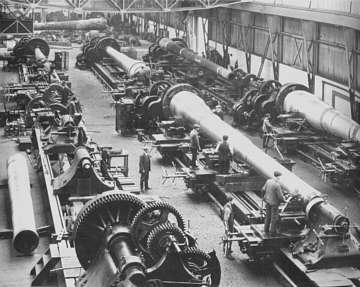
The City also began to manufacture war tanks, and aircraft parts. At the time of WWII, the City was obviously a huge military target.
On November 14th 1940, Coventry suffered the biggest single air attack upon ANY British city during World War II. Mainly the factories and buildings suffered from the heavy bombing. The old cathedral was destroyed along with 75% of the inner area of the city.
But, since the end of the War, "Foles Hill" is a very different place. Although some of the war factories can still be seen today, Foleshill re-emerged as the leading industrial park of Coventry due to the regeneration program sponsored by the local Chamber of Commerce.
As it also occurred in the United States, shortly after the War the "New Consumerism" era broke out and the 1950's and 1960's were periods of rapid growth in the auto industry. Many of England's major car manufacturers were now based in Coventry - Daimler/Rolls Royce, Talbot/Hillman/Humber, Standard-Triumph, and Jaguar. The city's Museum of British Road Transport holds a collection of around 200 cars, bicycles, buses and other road vehicles. In the 1970's the motor car industry entered a decline. Today the only car manufacturers in the City are Jaguar, which has a manufacturing plant at Browns Lane, and a successful Peugeot assembly plant at Ryton.
New manufacturing industries which have gained strength in the past decade include technical service industries and telecommunications. Many large service-oriented companies are located in business parks around the edge of the City. The Marconi Company, which manufactures telecommunications and Internet switching equipment, has a plant in the city.
The historical City of Coventry is known as "The Godiva City of the 3 Spires". It is famous for the legend of "Lady Godiva's Ride".
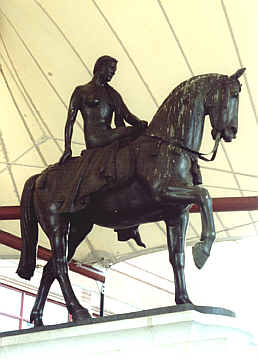
Coventry has ALWAYS BEEN an important historical city in this region. To bear witness to this fact, there are many historical buildings that can still be found in the City.
St. Michael Church
St. Michael's Church in Coventry is what Britons think of as "the old cathedral" - becoming elevated, to a cathedral in 1918. It is in fact the second cathedral. St. Mary's Priory Cathedral being the first.
In 1086 the city was granted to the Earls of Chester and Bishop de Lymesay became abbot of the priory. Under him the City became divided in two. The Priors Half and the Earls Half.
At first, the Priors Half was more powerful and subsequently the church of Holy Trinity became the parish church for the Priors Half.
St. Michael's was the parish church of the Earls Half of the city and was used by his tenants. These two churches are both in the Centre of the City not more than 50 yards apart and both sitting on the hilltop. This explains why there are two churches so close together. (The first Cathedral of St. Mary's was a monastery too and so did not survive the ravages of Henry VIII's dissolution of the monasteries).
St. Michael's was built in stages around the 1370's. The Botoner brothers, William and Adam, rich merchants of the time, paid for the construction of the tower and their sisters, Ann and Mary, paid for the construction of the spire some 40 years later. There was said to be a brass plaque in the church that reads..
William and Adam Built the tower,
Ann and Mary built the spire.
William and Adam built the church,
Ann and Mary built the choir.
The overall tower is some 300 feet in height standing on a base of around 30 feet square. There is a stone staircase that you can use to climb to the top of the tower. A well worth while climb though breathtaking for reason of exercise too. In 1773 thousands of pounds were expended on overcoming subsidence.
At the outbreak of the war in 1939, the stained glass from the cathedral was removed. It is now in the undercroft of the new Cathedral. The peace was broken in 1939 with the outbreak of war. As Coventry was a major manufacturing centre it was a natural target for the Luftwaffe. On the night of November 14th 1940 the City was attacked. The moon was bright. Coventry was nicely laid out below them clear and sharp. Incendiary bombs formed part of the attack ordinance and a stick of these hit the cathedral setting the roof timbers alight. The cathedral was destroyed as well as a large proportion of the City. A total of 449 German bombers attacked the City, dropping around 500 tons of high explosives and more than 40,000 fire bombs. The City centre was unrecognizable after the war.
The following morning the tower and spire still stood, rather like the tower and spire of Christ Church. A crucifix of two charred timbers was formed and placed on the altar and a cross of medieval nails was formed also.
The decision to rebuild the Cathedral was made that same day and a competition was launched to find the successfull designer. The winner was Basil Spence (1907-1976). Mr. Spence was later knighted for his achievements in Coventry. Later he joined with Henk Snoek, a photographer, to produce a book entitled "Out of the Ashes - a progress in pictures through Coventry Cathedral". This book, though now long out of print and containing only black and white images, manages to portray the dawn of new hope which surrounded the consecration of the Cathedral on the 25th of May 1962.
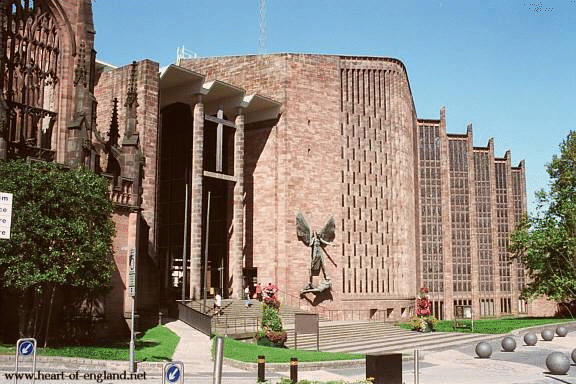
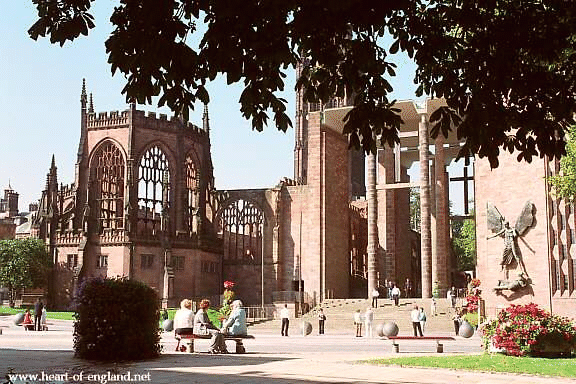

The New Cathedral viewed
over the wall of the old.
The skeletal spire can be
seen atop the New Cathedral.
It was lifted into place by a
helicopter during construction.
The foundation stone was laid by HM The Queen on 23rd March 1956 by which time the works had been in progress for 12 months. Such was the scale of the contract and such was the reason for it being carried out that many offers of donations came from around the world. Gifts arrived from Germany, Canada, Hong Kong, Sweden and other countries.
The new cathedral stands at right angles to the old. The construction is monumental and striking in its proportions but not overbearing. It is faced with the same Red Coventry sandstone that the old cathedral was constructed from, as are many buildings in the area.
Never has the phrase "the whole is greater than the sum of it's constituent parts" been more clearly demonstrated than in the final outcome of the efforts of so many. The Cathedral is a working church set in the centre of one of Britain's most productive cities. It is a credit to all those who worked on its creation. It is a credit to the city and it is a credit to the concept of forgiveness. Truly, Coventry has risen from the ashes of the Blitz!
Holy Trinity Church
Holy Trinity Church (which together with St. Michael's, and Christ Church's spires make up the three spires of the city of Coventry skyline) was built on the site of a former older church around the late part of the 12th or the early part of the 13th centuries. The North Porch contains stonework from the time of Leofric and Godiva that was possibly sourced from the earlier church.
When Holy Trinity was built (for the tenants of the Northern side of Coventry - The priory lands) the hilltop on which it was built was dominated by the Benedictine friary that became the original (first Cathedral) of St Mary's. St. Michael's (which became the second, and now ruined, cathedral) was built slightly later to serve the tenants of the Earl's lands. This serves to explain why so many churches built so closely together.
Holy Trinity is the most original Medieval church in Coventry and, being some 72 metres (237 feet) high to the top of the spire and 59 metres (194 feet) long, it is almost "Cathedral" in size. The church has seen many changes in it's life in fact it was nearly destroyed by fire in 1257. So it has seen much redecoration over the years. The church remains, however, a quiet haven in the centre of a bustling city.
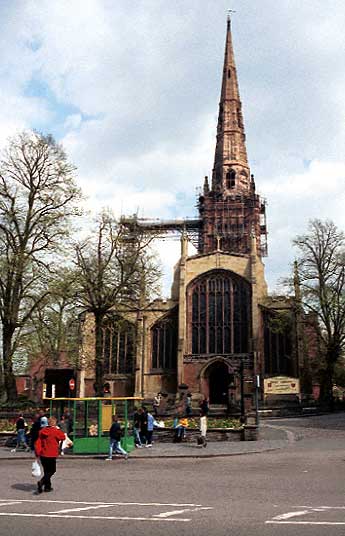
The West face and spire fronting
onto Broadgate- which it has
occupied for over 900 years.
Imagine all the people who've
attended church throughout
the years!
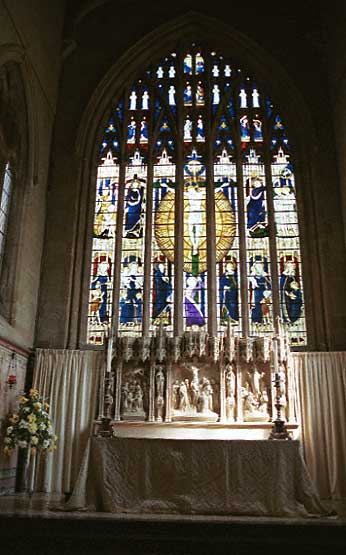
On December 3rd 1764,
Charles Lomax and Mary Smith
likely stood at this beautiful altar
to receive the sacrament
of Matrimony.
Christ Church
Christ Church stands between New Union Street and Warwick Lane. It is the third of the famous "3 Churches of Coventry". The original church on this site was built in the early 1200's by Franciscan monks known as the Greyfriars and was much larger than its 19th century rebuild - 240 feet in length by 60 feet wide. The structure was cruciform in shape and straddled the centrally placed spire. However, it became another of Coventry's victims to King Henry VIII's dissolution of the monasteries in 1538. Fortunately, the tower and spire were retained, keeping for Coventry it's third spire for which it is now famed.
By the beginning of the 1800s Coventry's population was again on the increase and with St. Michael's parish alone containing over 12,000 inhabitants it became a priority to build another church to share the load. By the mid 1820s donations and subscriptions had been collected and the existing tower with spire was given to the church by Coventry Corporation. The second half of the decade was spent on the final obstacle of freeing up the land around the spire that had been built upon since the project was begun.
The foundation stone was laid on the 16th March 1830 and Bath stone with brick was used for its construction. By spring 1832 it was complete and had its consecration ceremony on the 3rd August that same year. Due to the restrictions of the surrounding buildings, the new Christ Church was only 124 feet
in length and 55 feet wide and the spire was now at one end of the church forming the chancel, rather than
centrally positioned.
However, the lifespan of the second church was even shorter than the first. It survived the first major air-raid of November 1940, but Coventry suffered two more air-raids of similar magnitude on the 8th and 10th April the following year, and it was the second of these that destroyed the main church building for the second time in its history. In spring 1950 the remains of the walls were demolished and Coventry's third spire now stands alone once more.
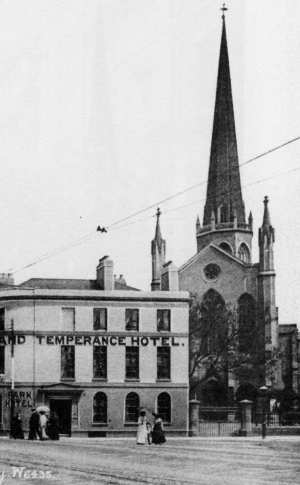
Christ Church 1813
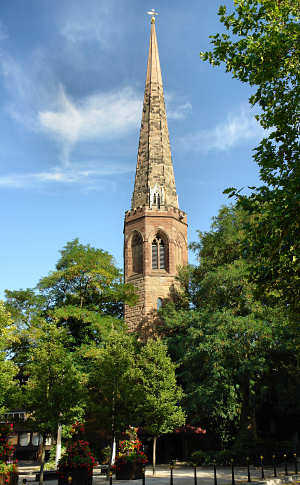
Christ Church 2006
Adjoining Parishes
Exhall (Near Coventry), Walsgrave-on-Sowe, Wyken, Stoke, Coventry.
Parish Registers
St. Lawrence
Christenings: 1564-1958
Marriages: 1565-1964
Burials: 1565-1974
Banns 1754-1955
St. Paul
Christenings: 1841-1962
Marriages: 1846-1958
Burials: 1845-1965 (St. Paul church was destroyed by bombs in World War II, but the registers were preserved).
Hawkesbury Iron Church
Christenings: 1908-1961
Longford, St Thomas
Christenings: 1874-1970
Marriages: 1892-1985
Burials: 1909-1958
Bishop's Transcripts: 1662-1836 LIC
IGI
St. Lawrence
Christenings: 1564-1876
Marriages: 1754-1877
St. Paul
Christenings: 1841-1874
Marriages: 1846-1876
Independent and some Baptist
Christenings: 1788-1837. Widely available; BMSGH(PS)
Register Copies
Christenings: 1554-1876
Burials: 1565-1877 SoG
St. Lawrence
Christenings: 1564-1913
Marriages: 1565-1911
Burials: 1565-1865 & 1877-1903
Banns 1777-1904 COV
St. Paul
Christenings: 1841-1904
Marriages: 1846-1902
Births: 1845-1965
COV NONCONFORMIST:
Roman Catholic: see Source Material and C, M & R Vol.2
Baptist:
Longford
Z 1769-1836
Burials: 1779-1837 WAR
Congregational: Z 1788-1837 WAR
Independent Z 1793-1837 PRO, COV
United Reformed Church Records 1796-1983
MONUMENTAL INSCRIPTIONS: St. Laurence BMSGH (RL), SoG
PROBATE RECORDS: LIC
CENSUS RETURNS: All (inc.Longford) WAR , COV (with street indexes)
1881 BIR
1881 BCP, BMSGH(PS
Indexes
Burial 1813-1837
Marriage 1754-1837
Poor Law c1690-1860
OTHER SOURCES: Copy of will of Richard Parrott 1721.
Survey of property of Richard Parrott in partnership with J.Bourne and T.Whieldon. Sumner of Foleshill
and Bedworth, bundles of deeds 1815-1907.
Map of estates in Foleshill 1781.
See also Gregory of Stivichal collection, STR
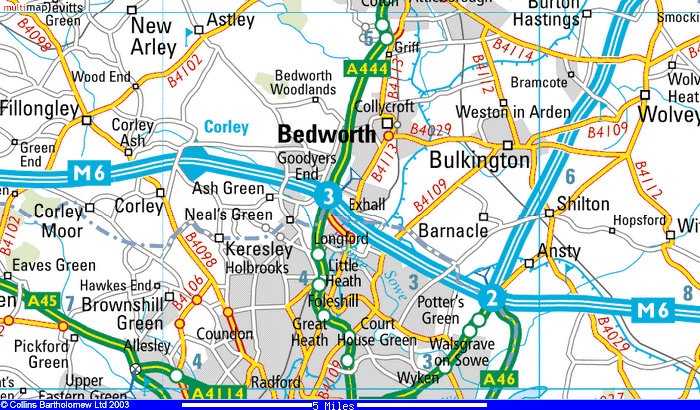
British maps confirm the location of
Little Heath and Great Heath south
of the junction of A444 and M6.
Ireland to Coventry

For at least four centuries, Irishmen have settled in Coventry. The greatest population rises were because of the famine in the 19th century and looking for work in the 20th century. The most common occupations were as labourers or in Coventry's factories, first making silk ribbon and then in the motor industry.
The famine in Ireland caused many to flee to Britain. This is documented in Coventry as the Irish-born population rose by 120% in twenty years, resulting in Coventry being the home to 704 people by 1861.
After the devastation of Coventry during World War II, people from Ireland were actively recruited to rebuild the city and to work in Coventry's hospitals and on the buses. The increase has continued steadily and at the 1991 census there were 13,540 Irish-born people in Coventry. The 2001 census had a new category for Irish ethnicity, through which many more people will have declared their Irish roots. Now the Irish community is spread throughout the city, with the areas of Coundon, Radford and Earlsdon being the most popular.
The Irish have made Coventry their home and have influenced the city throughout. Several Irish councillors have become Lord Mayor of the city, for example, and the Irish culture is evident in a number of the city's venues and events. Irish dance halls, clubs, pubs, dancing schools, theatre groups, language teachers and musicians are permanent features of the city. In addition, the Irish festival, St Patrick's celebration and the Irish pageant are now long-standing annual events. Coventry is also home to successful Irish businesses. These include travel agents and shops such as Gaffneys and Country Kitchen, which sell traditional Irish groceries.
|
|
 A responsive and mobile-friendly website
A responsive and mobile-friendly website